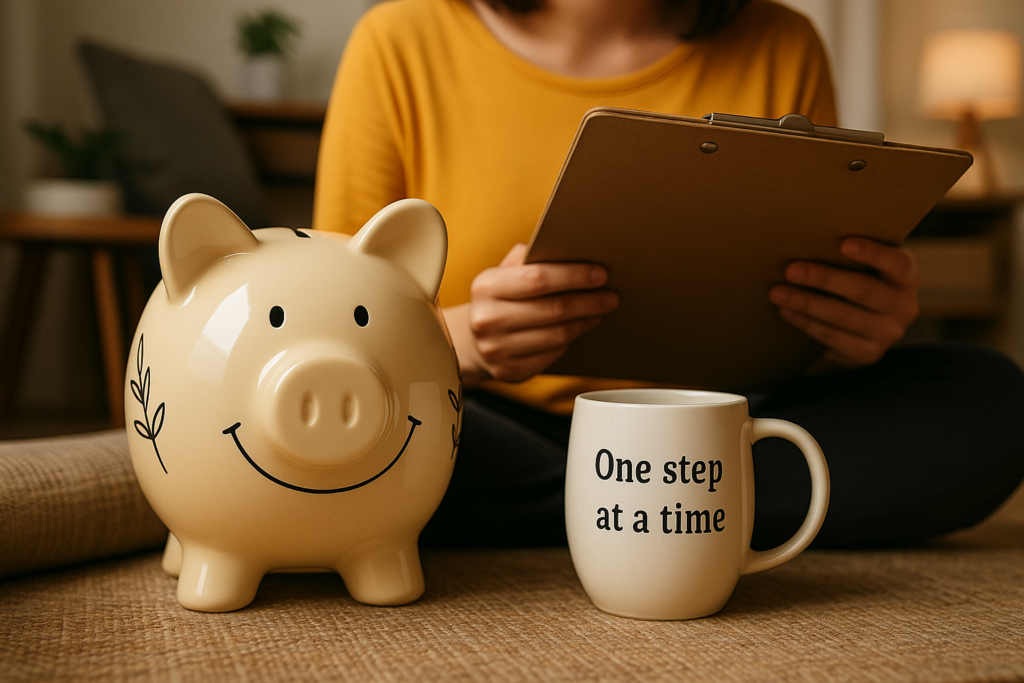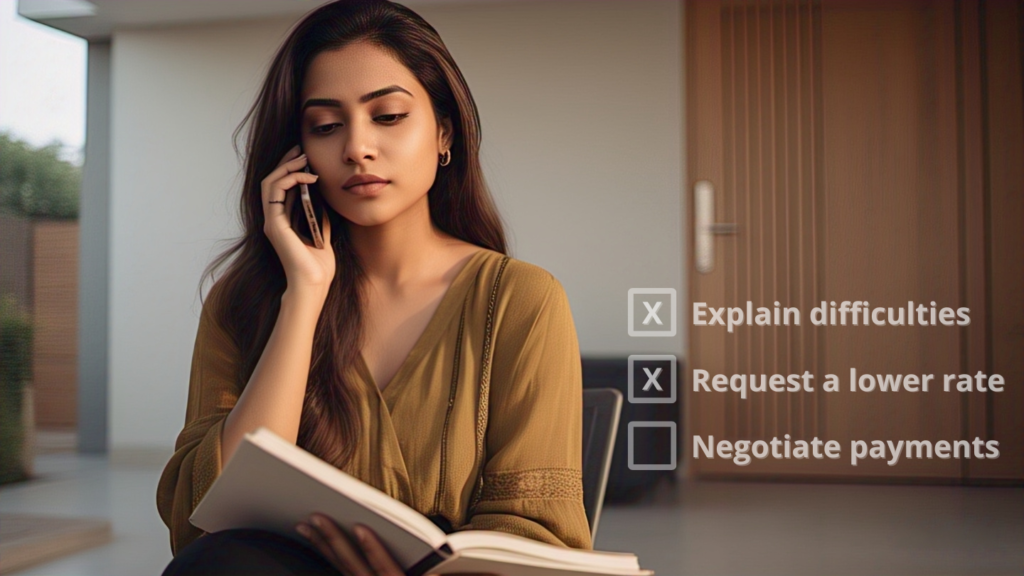Get Out of Credit Card Debt Even on a Tight Budget
Hey there! So you’re stuck with credit card debt and don’t have much wiggle room in your budget? Been there. Trust me, you’re not the only one trying to make ends meet while those credit card bills keep piling up.
I remember staring at my own stack of bills a few years back, wondering how on earth I’d ever dig myself out. But here’s the thing – it’s totally possible to break free from credit card debt, even when money’s tight. Let’s talk about how.
The Credit Card Mess Most Americans Are In
Credit card debt is like that unwelcome houseguest who just won’t leave. Right now, the average American household is carrying around $7,000 in credit card debt. Yikes.
What makes it worse? Those crazy interest rates. I mean, have you looked at yours lately? Most cards charge somewhere around 20% or higher. That’s nuts! At that rate, a $3,000 balance can take forever to pay off if you’re just making minimum payments.
My neighbor Tom was just telling me how he’d been making minimum payments for years on a $5,000 balance. Know how much he’d paid in interest alone? Over $4,000! And he still owed most of the original amount. Talk about a treadmill that goes nowhere.
Why It’s So Darn Hard to Pay Off Cards When Money’s Tight
When you’re already counting pennies, finding extra cash for debt payoff feels impossible. Does this sound familiar?
Your paycheck comes in. Bills eat most of it. Something unexpected happens – car repair, doctor visit, whatever. There’s not enough cash, so you pull out the credit card. Then interest piles up, making the hole deeper.
Rinse and repeat, month after month.
It’s exhausting, right? You work hard but can’t seem to get ahead. I get it. But even small changes can start breaking this cycle.
First Things First: Face Your Numbers
OK, this part isn’t fun, but we gotta do it. You need to know exactly what you’re dealing with.
Grab a Piece of Paper and List Every Card
For each credit card, write down:
- The name of the card
- How much you owe
- The interest rate (that percentage number)
- Minimum payment amount
- When it’s due each month
Don’t hide any cards, even the ones with small amounts. Get it all out in the open.
I remember doing this myself and finding a store card I’d forgotten about. It only had a $200 balance, but the interest rate was 29%! That little card was costing me big bucks.
Add It All Up
Total up what you owe across all cards. Then add up all those minimum payments to see how much is going out each month just to stay afloat.
The number might make you queasy. That’s OK. Knowledge is the first step to fixing things.
Take a Fresh Look at Where Your Money Goes
Now, where does your paycheck actually go? Most people honestly don’t know exactly.
Try this: for two weeks, write down every single thing you spend money on. That coffee run? Write it down. Vending machine snack? Yep, that too. You might be surprised where your dollars are sneaking off to.

Making a Plan That Actually Works When Money’s Tight
Now for the good part – making a plan you can actually stick to with your budget.
The Snowball Method: Small Wins Keep You Going
Here’s an approach that worked wonders for me – the snowball method. It’s super simple:
- Pay the minimum on all your cards
- Put any extra money toward your smallest balance
- Once that card is paid off, take that payment and add it to the next smallest balance
- Keep going until you’re debt-free
Let’s say you have three cards:
- A store card with $500 balance ($25 minimum)
- A Visa with $2,000 balance ($50 minimum)
- A Mastercard with $4,500 balance ($100 minimum)
You’d pay the minimums on the Visa and Mastercard but throw any extra cash at that $500 store card. Even an extra $25 or $50 a month would knock it out pretty quick.
Once that’s done, you’d take the $25 you were paying on it and add it to the Visa payment. Now you’re paying $75 instead of $50 on that card. See how it builds?
The best part? Those small wins keep you motivated. Paying off that first card feels AWESOME.
The Avalanche Method: Math-Smart but Tougher
If you’re a numbers person, you might prefer the avalanche method:
- Pay minimums on everything
- Put extra money toward the card with the HIGHEST interest rate
- Once that’s paid, move to the next highest rate
This approach saves you the most money overall. But if your highest-rate card also has a big balance, it might take longer to see progress. For most folks who are tight on cash, seeing quick wins with the snowball method works better.
Finding Extra Money When There Is None
“But I don’t have extra money!” I hear you. Yet there’s almost always something that can be adjusted, even temporarily.
The Little Expenses That Eat Your Lunch
It’s usually not the big stuff that’s killing your budget – it’s the little things that add up:
- That streaming service you barely watch ($15)
- The coffee shop stops ($5 here, $5 there)
- Grabbing lunch out instead of packing ($10-15 a pop)
- Convenience store drinks and snacks ($3-4 each time)
My weakness was stopping for energy drinks. At $4 a pop, 3-4 times a week, I was blowing about $60 monthly without thinking about it. When I switched to bringing tea from home, that $60 went straight to my debt.
Even saving $25 a week means $100 a month toward debt. That’ll make a dent!
Short-Term Pain, Long-Term Gain
Remember – these changes don’t have to be forever. Just until you’re debt-free:
- Cook at home instead of ordering in
- Hit up the library for books and movies
- Look for free stuff to do in your town
- Shop with a grocery list (and stick to it!)
- Use coupon apps like Ibotta or Rakuten
My family made Friday night our “free fun night” during our debt payoff. We’d find free events, have picnics in the park, or host game nights instead of going out. Not only did we save money, but we actually made better memories.
Bringing in Extra Cash
Sometimes cutting back isn’t enough. You might need to bring in more money:
- Sell stuff you don’t use (that exercise equipment collecting dust?)
- Pick up a few delivery gigs on weekends
- Offer a service based on what you’re good at (pet sitting, lawn care, handyman work)
- Ask about overtime at work
- Look for a side hustle you can do in your spare time
I started doing pet sitting on weekends and made an extra $200-300 monthly. It wasn’t glamorous, but that money went straight to my credit cards.
Talking to Credit Card Companies (They’re People Too!)
Here’s something most folks don’t know – credit card terms aren’t set in stone. You have more power than you think.

Just Ask for a Lower Rate
Seriously, just call them up and ask! Be polite but straightforward:
“Hi there. I’ve been a customer for X years, and I’m working hard to pay down my balance. I’ve gotten offers from other cards with lower rates. Could you lower my interest rate to help me pay off my balance faster?”
About 7 out of 10 people who ask get some kind of reduction. One phone call could save you hundreds.
When I called about my highest-rate card, they dropped my rate from 24% to 16% on the spot. That five-minute call saved me over $400 that year.
Hardship Programs (The Credit Card Industry’s Secret)
If you’re really struggling, many card companies have special hardship programs. They don’t advertise these much, so you have to ask specifically.
These programs might include:
- Lower interest rates for a while
- Smaller minimum payments
- No more late fees
- Special payment plans
Ask about “hardship options” or “assistance programs” when you call. Be honest about your situation.
Settling for Less Than You Owe
In some cases, creditors might take a lump sum that’s less than what you owe to close the account. If you have some savings or can borrow from family, you might offer to pay 50-70% of the balance all at once.
This will ding your credit score, but it might be worth it if you’re already behind on payments.
Consolidation Options That Don’t Require Perfect Credit
Combining your debts can make things simpler and potentially lower your interest rates.
Balance Transfer Cards: The 0% Game-Changer
If your credit is still OK, balance transfer cards can be a huge help. These let you move high-interest debt to a new card with 0% interest for a limited time (usually 12-18 months).
Watch out for:
- Transfer fees (usually 3-5% of what you transfer)
- The regular rate that kicks in after the promo period
- Annual fees
This works best if you can pay off the debt during that 0% period. I transferred $4,000 to a 0% card and focused all my extra money on paying it off before the promo rate expired. Saved about $800 in interest that year.
Personal Loans: One Payment, Lower Interest
A fixed-rate personal loan often has way lower interest than credit cards. You use the loan to pay off all your cards, then make one payment each month.
The good stuff:
- Lower interest rates (maybe half of what credit cards charge)
- One fixed payment
- Clear end date
- Much simpler than juggling multiple cards
Look for loans with no origination fees and no penalties for paying early.
Home Equity: Powerful but Risky
If you own a home with equity, you could use it to pay off credit card debt. But be careful – if you can’t make the payments, you could lose your home.
I generally don’t suggest this unless you’re super stable in your income. Your credit card company can’t take your house, but your mortgage lender can.
Building Better Money Habits Along the Way
Getting out of debt is one thing. Staying out is another.
The Emergency Fund: Your Debt Prevention Tool
Even a small emergency fund can keep you from new debt. Try to set aside at least $500-1,000 for unexpected expenses while you’re paying off debt.
With that cushion, when your car breaks down, you can pay cash instead of reaching for the credit card. After you’re debt-free, build it up to 3-6 months of expenses.
I started with just $25 a week until I hit $1,000. That fund saved me from new debt at least five times during my payoff journey.
Cash Is King: The Envelope System
Many people find that using actual cash helps them stick to their budget. The envelope system is dead simple:
- Get envelopes for different spending categories (groceries, gas, fun money)
- Put the budgeted amount of cash in each envelope
- When an envelope is empty, you’re done spending in that category until next month
It’s way harder to overspend when you can physically see the money disappearing.
What Makes You Swipe That Card?
Pay attention to when and why you use credit cards:
- Shopping when you’re feeling down?
- Spending to celebrate good news?
- Buying stuff to keep up with friends?
- Shopping out of boredom or habit?
Notice your triggers and find other ways to deal with those feelings. Call a friend, go for a walk, or find a free hobby you enjoy.
I realized I was an “emotional shopper” after a stressful day at work. Started going for runs instead of to the mall. Saved money AND got healthier!
Real People, Real Success Stories
Sometimes it helps to hear from folks who’ve been there and done it.
Sarah’s Story: Single Mom, Big Victory
Sarah works as an admin assistant making about $35,000 and raises two kids on her own. After her divorce, she was drowning in $15,000 of credit card debt.
First, she called her credit card companies and got lower interest rates – that saved her $50 monthly right away. Then she started babysitting on weekends, bringing in an extra $200 each month.
Sarah focused on her smallest card first. It took her three years to become debt-free, but she did it while still making sure her kids had a good Christmas each year and could enjoy free community events.
Her advice? “Take it one day and one dollar at a time. And celebrate every win, no matter how small.”
Mike’s Story: Factory Worker to Debt-Free
Mike works at a manufacturing plant making around $42,000. He racked up $20,000 in credit card debt after some medical issues and, as he puts it, “being young and dumb with money.”
He got serious by downsizing from his one-bedroom apartment to sharing a house with roommates, cutting his housing costs by $400 monthly. Then he sold his newer car and bought a reliable older model, eliminating his car payment.
With the extra $600 monthly, Mike attacked his highest-interest debt first. He also picked up overtime whenever possible. In just over two years, he was debt-free and had learned to live comfortably on less.
“The freedom feels way better than any of the stuff I was buying,” he told me.
Free Tools to Help You Along the Way
You don’t have to figure this all out alone. There are plenty of free resources out there.
Apps That Make Budgeting Less Painful
Several great free apps can help you track spending and stay on top of debt payoff:
- Mint (tracks expenses and shows where your money goes)
- Personal Capital (gives you a big-picture view of your finances)
- EveryDollar (simple budgeting)
- Good old spreadsheet templates (free online)
I used Mint to track every penny and loved watching my debt numbers go down each month.
Credit Counseling: Free Expert Help
Nonprofit credit counseling agencies offer free or cheap counseling sessions. They can help you:
- Look at your situation objectively
- Create a personal budget
- Develop a debt plan
- Sometimes even negotiate with your creditors
Look for agencies approved by the National Foundation for Credit Counseling. They’re the real deal, not those scammy “debt relief” places you see on late-night TV.
Community Classes and Workshops
Many communities offer free financial workshops through:
- Libraries
- Community colleges
- Churches and religious organizations
- Nonprofits
These often cover budgeting, debt management, and saving strategies. Plus, you’ll meet others in the same boat, which helps a ton.
When You Need Bigger Guns
Sometimes regular debt payoff strategies aren’t enough, especially if your debt is really high compared to your income.
Debt Management Plans: Professional Help
A debt management plan (DMP) through a nonprofit credit counseling agency consolidates your payments and often gets you lower interest rates. You make one monthly payment to the agency, which pays all your creditors.
The good stuff:
- Lower interest rates
- No more fees
- One simple payment
- Clear timeline (usually 3-5 years)
DMPs usually mean closing your credit accounts and might affect your credit score at first, but they can be super effective for serious debt problems.
The B-Word: Bankruptcy
If your debt is truly overwhelming compared to your income, bankruptcy might be worth thinking about. This is a serious step with long-lasting credit consequences, so always talk to a bankruptcy attorney first. Many offer free consultations.
Signs bankruptcy might make sense:
- It would take more than 5 years to pay off your debt even with aggressive strategies
- Debt collectors are suing you
- You’re at risk of losing important assets
- You’re using credit for basics like food and utilities
Protecting Your Credit While You Pay Down Debt
Your credit score might take a temporary hit during debt payoff, but there are ways to minimize the damage.
Credit Utilization: The 30% Rule
Credit utilization (how much of your available credit you’re using) has a big impact on your score. As you pay down balances, your utilization decreases, which helps your score.
Try to keep accounts open even after paying them off. This keeps your available credit high and your utilization percentage low.
Pay on Time, Every Time
Payment history is the biggest factor in your credit score. Even if you can only make minimum payments on some cards, make sure you pay on time, every single month.
If possible, make payments before the statement closing date (not just before the due date). This ensures lower balances get reported to credit bureaus.
Keep an Eye on Your Reports
Check your credit reports during your debt payoff journey. You can get free weekly credit reports from all three bureaus through AnnualCreditReport.com.
Look for:
- Payments being reported correctly
- Balance information being accurate
- Any errors or weird activity
If you spot an error, dispute it right away to protect your score.
Staying Motivated When It Gets Tough
Paying off debt on a tight budget is like running a marathon. Staying motivated is key.
Celebrate the Small Stuff
Notice and celebrate every victory, no matter how small:
- Your first $500 paid off
- The first time you pay more than the minimum
- Going a full month without new charges
- Negotiating a lower interest rate
Treat yourself to something small but meaningful when you hit milestones – maybe a movie night at home or a visit to that park you’ve been wanting to check out.
See Your Progress
Visual reminders can be super motivating:
- Make a debt thermometer you can color in as you pay off each chunk
- Take monthly screenshots of your accounts showing the decreasing balances
- Keep a chart on the fridge showing your progress
Seeing the numbers go down makes all the difference on tough days.
Find Your People
Debt payoff can feel lonely, especially when you have to say no to spending money with friends. Finding support helps:
- Online communities like Reddit’s r/debtfree
- A money buddy who’s also paying off debt
- Financial groups on social media
Just knowing you’re not the only one struggling can make a huge difference.
My sister and I were both paying off debt at the same time, and we’d text each other our wins each week. Having someone to share the journey with kept me going when I wanted to give up.
Life After Credit Card Debt
Imagine your life without those monthly credit card payments sucking up your income. What would you do with that money instead?
Where to Put That Money Now
Once you’re debt-free, redirect those former payments toward building real wealth:
- Build up your emergency fund
- Start saving for retirement
- Save for a home down payment
- Put money aside for your kids’ education
- Invest in yourself through education or training
The money that used to go to credit card companies could now be building your future instead.
Using Cards the Smart Way
Credit cards themselves aren’t evil – it’s how we use them that causes problems. Once you’re debt-free, you might:
- Use one card for specific things only (like gas or online shopping)
- Pay the balance IN FULL every month
- Set up automatic payments so you’re never late
- Take advantage of rewards without carrying balances
- Check statements regularly for mistakes or fraud
I now use one card for everything but pay it off weekly. I earn the travel rewards but never pay a cent of interest.
The Freedom Factor
Without credit card debt, you gain options you didn’t have before:
- Freedom to change jobs without panic
- Ability to cut back work hours if you want
- Room to try entrepreneurial ideas
- Capacity to help others financially
- Peace of mind about unexpected expenses
This freedom is worth every sacrifice made during your debt payoff journey.
You Can Do This!
Getting out of credit card debt on a tight budget isn’t quick or easy. It takes persistence, creativity, and sometimes tough choices. But tons of people with situations just like yours have done it. You can too.
Start where you are. Use what you have. Do what you can.
Each dollar you put toward debt is a step toward freedom. Each interest charge you avoid is money back in your pocket. Each day you stick to your plan brings you closer to your goal.
Remember – your financial situation is just one part of who you are. It doesn’t define your worth or your future. With some grit and patience, you can kick that credit card debt to the curb, even on a tight budget.
I believe in you. Now get started!
Key Takeaways
- You CAN get out of credit card debt even with limited income – thousands have done it
- Start by facing your numbers – list every card, balance, and interest rate
- Choose either the snowball method (smallest balances first) or avalanche method (highest interest first)
- Find extra money by cutting small expenses, making temporary changes, or bringing in side income
- Don’t be shy about calling card companies to ask for lower rates or hardship programs
- Consider balance transfers or personal loans if they’ll significantly cut your interest
- Build a small emergency fund while paying off debt to prevent new debt
- Use free tools like budgeting apps and nonprofit credit counseling
- Protect your credit by making on-time payments and keeping accounts open
- Stay motivated by celebrating small wins and tracking your progress visually
- Remember that financial freedom is worth the temporary sacrifices
Meta Description: Drowning in credit card debt with a tight budget? Don’t stress! Discover real-world strategies to knock out your debt without a big income. Learn how to negotiate lower rates, find hidden money in your budget, and stay motivated until you’re debt-free.



